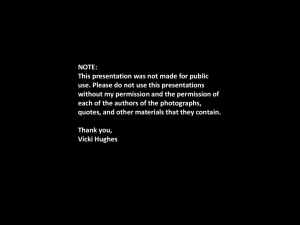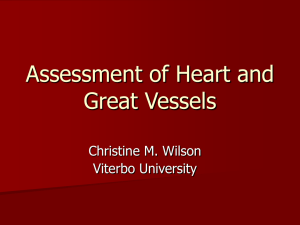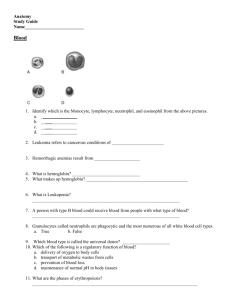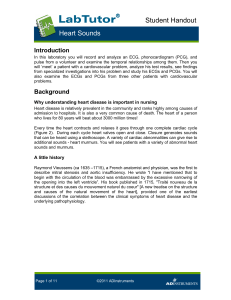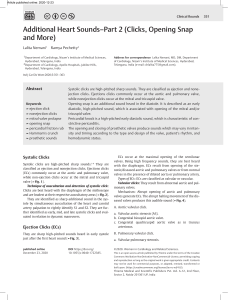Normal heart sounds
advertisement
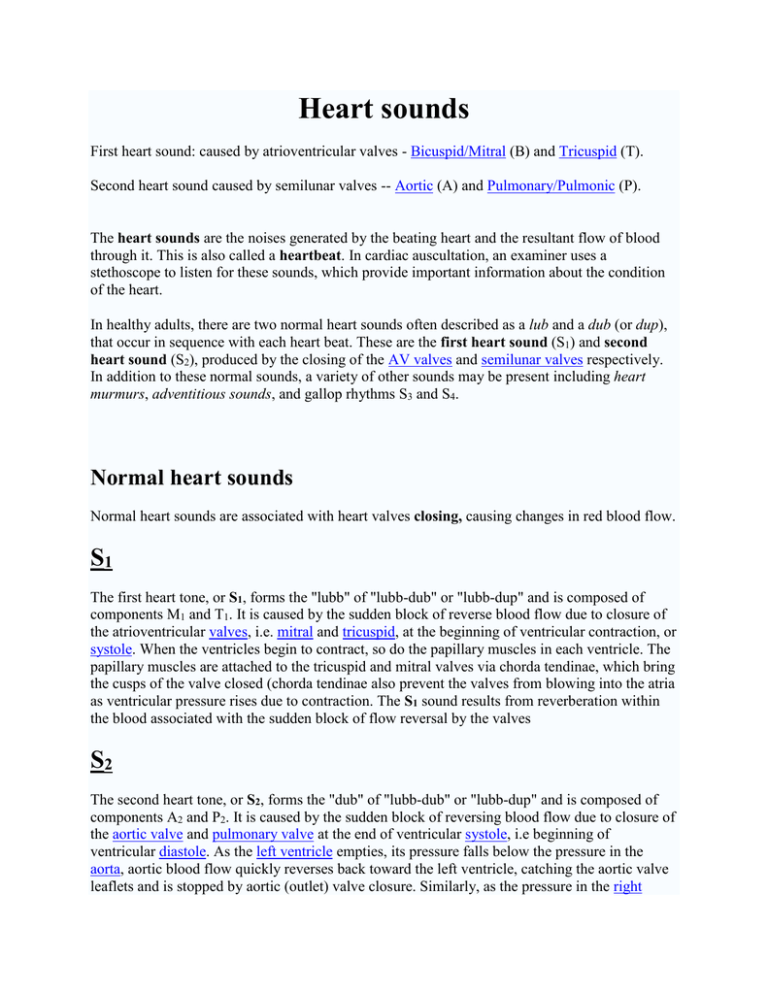
Heart sounds First heart sound: caused by atrioventricular valves - Bicuspid/Mitral (B) and Tricuspid (T). Second heart sound caused by semilunar valves -- Aortic (A) and Pulmonary/Pulmonic (P). The heart sounds are the noises generated by the beating heart and the resultant flow of blood through it. This is also called a heartbeat. In cardiac auscultation, an examiner uses a stethoscope to listen for these sounds, which provide important information about the condition of the heart. In healthy adults, there are two normal heart sounds often described as a lub and a dub (or dup), that occur in sequence with each heart beat. These are the first heart sound (S1) and second heart sound (S2), produced by the closing of the AV valves and semilunar valves respectively. In addition to these normal sounds, a variety of other sounds may be present including heart murmurs, adventitious sounds, and gallop rhythms S3 and S4. Normal heart sounds Normal heart sounds are associated with heart valves closing, causing changes in red blood flow. S1 The first heart tone, or S1, forms the "lubb" of "lubb-dub" or "lubb-dup" and is composed of components M1 and T1. It is caused by the sudden block of reverse blood flow due to closure of the atrioventricular valves, i.e. mitral and tricuspid, at the beginning of ventricular contraction, or systole. When the ventricles begin to contract, so do the papillary muscles in each ventricle. The papillary muscles are attached to the tricuspid and mitral valves via chorda tendinae, which bring the cusps of the valve closed (chorda tendinae also prevent the valves from blowing into the atria as ventricular pressure rises due to contraction. The S1 sound results from reverberation within the blood associated with the sudden block of flow reversal by the valves S2 The second heart tone, or S2, forms the "dub" of "lubb-dub" or "lubb-dup" and is composed of components A2 and P2. It is caused by the sudden block of reversing blood flow due to closure of the aortic valve and pulmonary valve at the end of ventricular systole, i.e beginning of ventricular diastole. As the left ventricle empties, its pressure falls below the pressure in the aorta, aortic blood flow quickly reverses back toward the left ventricle, catching the aortic valve leaflets and is stopped by aortic (outlet) valve closure. Similarly, as the pressure in the right ventricle falls below the pressure in the pulmonary artery, the pulmonary (outlet) valve closes.The S2 sound results from reverberation within the blood associated with the sudden block of flow reversal. S3 Third heart sound Rarely, there may be a third heart sound also called a protodiastolic gallop,or ventricular gallop. It occurs at the beginning of diastole after S2 and is lower in pitch than S1 or S2 as it is not of valvular origin. The third heart sound is benign in youth and some trained athletes, but if it re-emerges later in life it may signal cardiac problems like a failing left ventricle as in dilated congestive heart failure (CHF). An S3 heart sound is best heard with the bell-side of the stethoscope (used for lower frequency sounds S4 Fourth heart sound The rare fourth heart sound is sometimes audible in healthy children and again in trained athletes, but when audible in an adult is called a presystolic gallop or atrial gallop. This gallop is produced by the sound of blood being forced into a stiff/hypertrophic ventricle. It is a sign of a pathologic state, usually a failing left ventricle, but can also be heard in other conditions such as restrictive cardiomyopathy. The sound occurs just after atrial contraction ("atrial kick") at the end of diastole and immediately before S1, producing a rhythm sometimes referred to as the "Tennessee" gallop where S4 represents the "tenn-" syllable. Murmurs Heart murmurs are produced as a result of turbulent flow of blood, turbulence sufficient to produce audible noise. They are usually heard as a whooshing sound. The term murmur only refers to a sound believed to originate within blood flow through or near the heart; rapid blood velocity is necessary to produce a murmur. Yet most heart problems do not produce any murmur and most valve problems also do not produce an audible murmur. Surface anatomy The aortic area, pulmonic area, tricuspid area and mitral area are areas on the surface of the chest where the heart is auscultated Pulmonary valve (to pulmonary trunk) second intercostal space left upper sternal border Aortic valve (to aorta) second intercostal space right upper sternal border Mitral valve (to left ventricle) fifth intercostal space Tricuspid valve (to right ventricle) fourth intercostal space lower left sternal border medial to left midclavicular line

